The shock absorber is an element of suspension, the direct responsibility of which is to clean all the blows and oscillations arising when the car is moving along the uneven surface. It is the shock absorber provides the driver and passengers comfort and convenience while driving.
Content
Device shock absorber
Regardless of the type and design of the shock absorbers, it consists of several basic elements. This is a working cylinder in a cylindrical case with eyelets to directly fasten the shock absorber to the body and the car suspension elements.

In addition, the cylinder is also the piston attached to the stock. The piston contains bypass valves and sealing rings. The bypass valves are designed to compress and return hydraulic fluid, which moves through the piston compression.
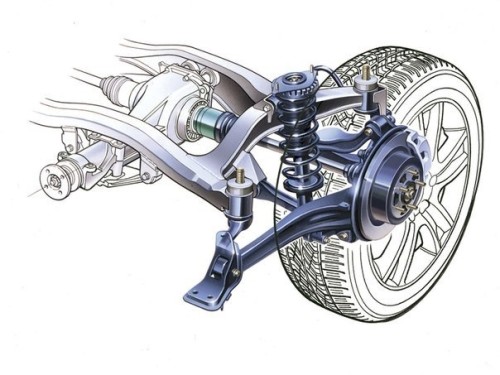
Basically, automobile shock absorbers are found, with purely gas and gas oil filling. In rare cases there are purely liquid shock absorbers (hydraulic).
Important! The gas-oil shock absorber is also quite common to refer to as a gas-liquid, combined or oleopneumatic.
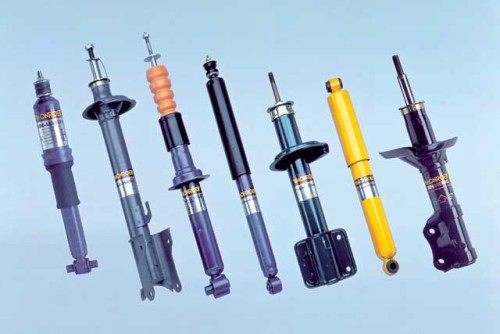
Consider more details these two types of car shock absorbers:
- Gas oil shock absorbers - they are also called two-pipe. In this type of shock absorbers, the working substance is both oil and gas. The work involves directly oil, and the gas removes the resulting foam.
- Gas shock absorbers - they are one-tube. In this type of shock absorber, the working substance is directly gas, but in essence such a shock absorber is also gas oil. Since it also has an oil with one difference. Oil and gas in such type of shock absorbers do not contact with each other.
Important! The designs of the gas oil and pure hydraulic shock absorber are completely identical.
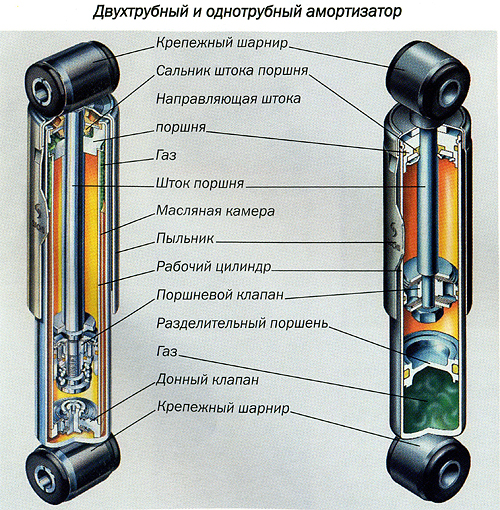
Signs of shock absorber malfunction
Faulty and worn shock absorbers entail a lot of other problems, consider carefully attributes for which you can define the malfunction of automotive shock absorbers:
Visual signs of shock absorbers:
- Deformation of the cylindrical case. The deformed shock absorber body is able to fully or partially hold the piston inside it. As a consequence, the shock absorber;
- The oil flows directly from the shock absorber. Oil leaks reduces damage index;
- Deformation or weakening of fasteners. With a high probability, when you ignore this problem, the attachment will be destroyed;
- Damage (deformation, cracks) fastening sleeves. Damaged sleeves with a high probability lead to the appearance of noise that occurs when driving around the uneven surface and speed set;
- Damaged shock absorber piston. Significantly increases rubber wear;
- Piston rod corrosion. Increases oil wear, as a result, oil leaks appear;
- Corrosion of springs support. With a high probability due to corrosion, the springs dish can break away.
In addition to the above-listed visual signs, the shock absorbers may also testify:
- Elevated wear of the tires;
- Significant "squat" the front of the car during braking;
- Significant "squat" the back of the car during acceleration;
- Car care in driving when turning;
- Rocking (left, right) car, when driving;
- Increased car shaking when driving;
- Poor clutch of the wheel of the car with a road surface;
- Sample suspension;
- Reducing the car charter at a speed of more than 80 km / h.
Faulty shock absorbers, which lead to faulty shock absorbers
Faulty shock absorbers extremely negatively affect both safety and comfort and the overall wear of other parts of the car. Consider more in more detail what kind of faulty car shock absorbers are:
- Significantly increases the brake path of the car. So, for example, when moving a car with a speed of 80km / h, with an ABS brake path increases by 6-10 meters, without ABS for 4-5 meters.
- The car is bad in turns. It begins to roll and extremely poorly holds the trajectory of movement;
- Any even a minor bump leads to a shaking and long swinging of the car;
- When driving around the wet surface, the effect of aquaplaning occurs by 10-20 km earlier;
- Significantly increases the load on all car suspension elements;
- Significantly increases car tire wear;
- Reduced clutch of a car with a road surface;
- The noise level created by the car is increasing when driving.
Interesting! The effect of aquaplamination is called the formation of a water wedge in the surface of the contact of the car tire with a road surface. If this effect occurs, the car almost completely loses controllability.
Oil shock absorbers how to check the shock absorber for performance
The advance detection of shock absorbers makes it possible to significantly reduce the cost of repairing the vehicle, and in some cases, to preserve the life of the driver and passengers. Checking the performance of shock absorbers under the power of each car owner and does not require special efforts:
- First of all, a visual inspection of the shock absorber should be carried out. There should be no signs of corrosion and deformation on the implicit items. In the event that it is covered with oil, it should be thoroughly wipe and produce, repeated after a couple of days for the flow;
- You should also make an inspection of the car tires for uniformity of wear, but it may not always talk about the malfunction of the shock absorbers. Uneven wear also occurs, for example, in the violation of "geometry" and some other faults;
- The rolling of the car is also very effective, contributes to the detection of malfunction of the shock absorbers. To do this, get in front of the car in front or rear. They will be lean on the hood or respectively the trunk and strongly shake it with all weight. After that, remove hands from him if the car makes more than one oscillation - this means about the need to replace shock absorbers;
- The serviceability of shock absorbers can also be checked during the movement of the car. Strong rolls when turning, strong swaying and shaking on the bumps, reduced car handling, etc. talk about the malfunction of the shock absorbers;
- A good verification option is to test the car on a special stand in the car service. During such tests, it is subjected to all sorts of loads. At this point, all data is removed from the car and processed on the computer, the output is a generated report.
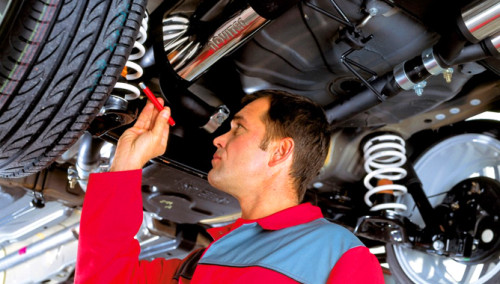
Shock absorbers characteristics how to check new shock absorbers
To date, the car market has a lot of poor-quality products. We will try to figure out how to check and select high-quality shock absorbers for the car. When buying car shock absorbers should:
- Visual inspection, for deformities and other mechanical damage. Also not allowed oil leaks;
- Verify marking. It must correspond to the manufacturer's catalog;
- Using the ruler, you can check the length of the rod. Deviations are not allowed more than 5 mm from the manufacturer's declared;
- A gas shock absorber (one-tube) must be pumped by hands about 5 times, while the movement of the rod must be uniform and smooth without bokery. When pumping, there should also be no extraneous sounds, in addition to the natural "suggestion".
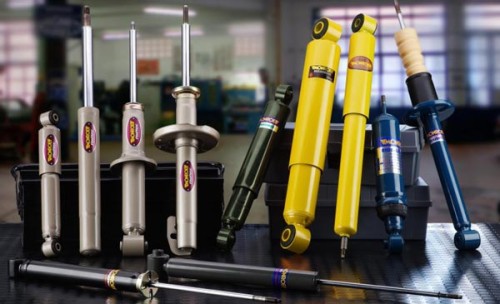
Tips of professionals
- The most reliable and correct way to choose shock absorbers to acquire them of the same type that have been installed when buying a car. Since they are provided directly to the design of the car;
- It is better to stop your attention to the well-proven car manufacturers of goods, but it is necessary to pick up shock absorbers compatible with your car. The manufacturers as BOGE, KAYABA, MONROE, SACHS, KONY, TRW are proven well well;
- In no case should not be installed on the car different shock absorbers;
- Gas shock absorbers are significantly tougher than their fellow. They increase car handling, but reduce comfort;
- Specialists recommend changing shock absorbers at least 80 thousand km of run after they are installed, but to inspect every 20 thousand km;
- Timely replaced shock absorbers will significantly maintain further expenses for the repair of the remaining suspension elements.
Related Materials
- Stove 2110, bad warm stove 2110, VAZ 2110 heating system, repairing the heating system VAZ 2110 with their own hands
- VAZ 2114 stove blows with cold air, stove 2114, bad warm stove VAZ 2114, device and repair of heating VAZ 2114 do-it-yourself, removing the stove VAZ 2114
- How to subdominize the car. How to put a jack. Types of jacks for cars.
- VAZ 2109 Fuse Block, VAZ 2109 Fuse Block Carburetor, VAZ 2109 Fuse Block Injector, Old VAZ 2109 Fuse Block, VAZ 2109 Fuse Block, VAZ Fuse Block 2109
- Car exhaust gas catalyst, faulty catalyst, pluses and cons of the catalyst, how to change the catalyst on the planeencitel
- Stove blowing cold air VAZ 2114, badly blowing the stove VAZ 2114, why badly blowing the stove VAZ 2114
- How to find out the owner of the car by the number of his car, check the car by the number of the traffic police machine, check the car by the state number of the car for free
- How to choose Used tires, Useful Tips
- Winter car road, pressure in passenger car tires in winter, good battery for the car in winter, whether to warm the car in winter
- In winter, the car is poorly started. How to make a car in winter, do you need to warm up the car in winter, useful tips
- Economy fuel consumption machines, the most economical car consumption
- Tires brands for passenger cars, labeling of car tire labeling, residual passenger car tire protector, how to pick a tire on a car brand, car tire tread pattern
- Working transmission operation, mechanical gearbox clutch work, driving with manual gearbox, useful tips
- Rear beam Peugeot 206 sedan, rear beam device Peugeot 206. Rear beam Peugeot 206 Malfunction, repair of the rear beam Peugeot 206
- Diesel fuel in winter, additive for diesel fuel in winter, how to choose the best diesel fuel
- Diesel winter does not start. How to start diesel in winter, heating diesel in winter.
- Tire marking decoding for passenger cars, labeling wheels, how to choose the right tires on the disks
- Diesel engine in winter, launch of the diesel engine in winter, what oil to fill in a diesel engine in winter, useful tips
- LED backlight of the car, the backlight of the bottom of the car, the backlight of the legs in the car, the backlight in the door of the car, the backlight of the car is fine
- Recovered tires, bus tire, restored tire protector, can I use them
- Choose winter tires, which is a winter tires, which pressure in winter tires should be marked with winter tires, how to choose the right winter tires, the best winter tires 2019
- Steering rail rail, knock of steering rack, reasons for the knock and repair of the steering rack do it yourself
- Cameless car tires, a set for repair of tubeless tires, repair of the cannon-free tire do it yourself
- Russian tires, Russian tires Winter, Russian All-season tires, Voronezh AMTEL tires, Tires "Matador Omsk Tire", Kama-tires are world-class bus
- How to open a car without a key. Lost the key from the car what to do, the key from the car inside the car
- Silent tires, quiet winter tires, quiet studded bus, which tires to choose, overview tires
- Tires and safety, safety of the bus, why it is necessary to constantly monitor car tires
- Rust converter which is better for cars, rust converters to choose how to use rust transducer, professionals
- Polishing the body of the car do it yourself, how to choose a polishing paste, useful tips
- Engine durability, engine life, how to extend engine life
- Knock in the car. Knock when moving the car. What can knock in the car. How to determine the cause of the knock.
- ABS car, what is ABS car, ABS system malfunction, ABS diagnostics
- Overtaking a car when you can start overtaking a car, rules of traffic rules
- Fuel pump VAZ 2110, VAZ 2110 gas station scheme, VAZ 2110 fuel pump device, VAZ 2110 gas station repair,
- Automotive antennas for radio, automotive antenna device, car antenna do it yourself
- Front suspension Kalina, device front suspension Kalina, knock in front suspension Kalina, repair of front suspension Kalina
- Shock absorber Oil, best oil shock absorbers, pumping oil shock absorbers, how to properly pump oil shock absorber
- Clutch malfunctions, touches clutch, causes a clutch malfunction, how to eliminate
- Viscounts of the fan, work uniforms of the fan, malfunction of the ventilator fan, repair of the ventilator fan
- Corrosion of car thresholds, film on car thresholds, how to stick a film on the thresholds of the car
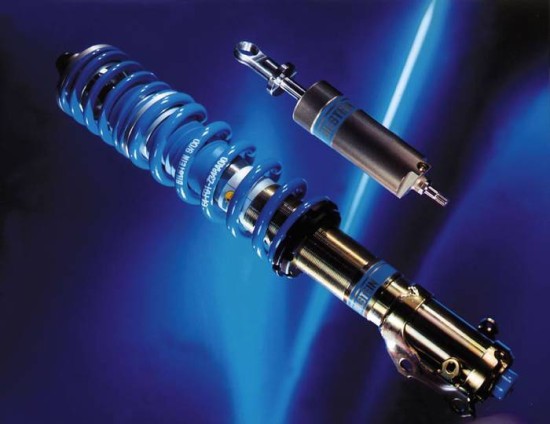
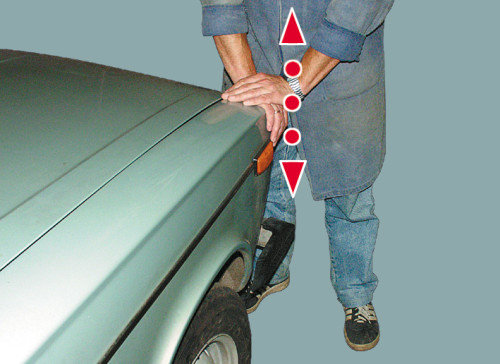






Comments